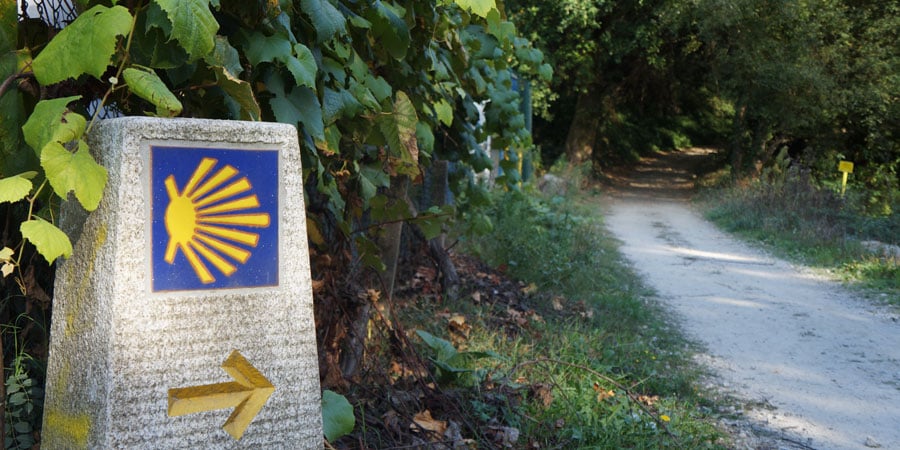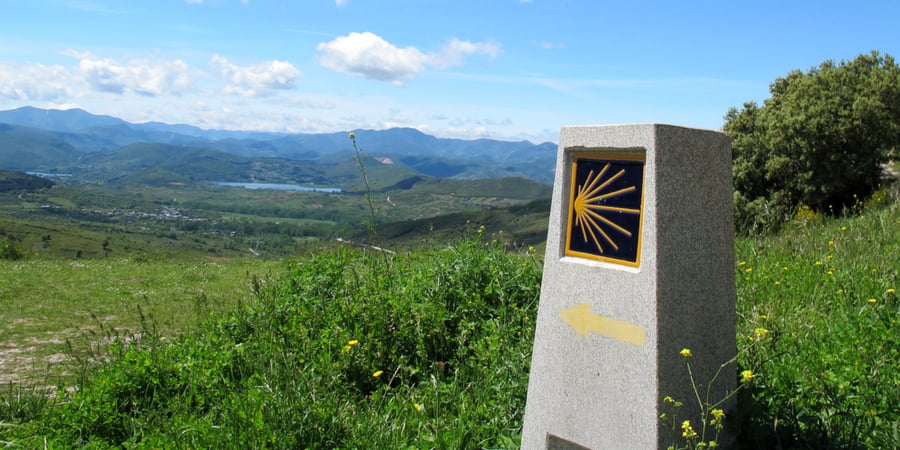The scallop shell and yellow arrow are the ‘symbols’ of the Camino de Santiago and these Camino Markings will guide you all the way to Santiago de Compostela. They are the ultimate Camino Markings. These simple symbols have guided millions of pilgrims across Spain and Portugal for centuries.
The scallop shell and the yellow arrow are more than just waymarkers, they are the beating heart of the Camino. They tell stories of faith, community and direction, guiding pilgrims safely all the way to Santiago de Compostela. Here’s why these Camino markings matter and how to follow them on your journey!
Table of contents
The Meaning of the Scallop Shell on the Camino
The scallop shell is one of the most iconic symbols of the Camino de Santiago. It is still used today to guide pilgrims to Santiago de Compostela along many routes.
Painted or printed on walls, sidewalks, tiles, or Camino markers, the scallop shell (or ‘Vieira’ in Galician and Spanish) will help you find your way.
The scallop shell is one of the most iconic and enduring symbols of the Camino de Santiago. Known as the vieira in Spanish and Galician, it appears everywhere along the route: painted on walls, engraved on stones, tiled into pavements and even hanging from pilgrims’ backpacks.

Its meaning goes beyond simple navigation. The scallop shell is believed to be a metaphor, its lines representing the different routes pilgrims travel from all over the world, all trails leading to one point: Santiago de Compostela.
Medieval pilgrims often wore scallop shells attached to their cloaks or hats for their journey to Santiago. More than being just a symbol or a pilgrim badge, the scallop shells also had a practical purpose.It served not only as a sign of their pilgrimage but also had a practical use, the curved shell could be used to scoop water or food along the way.
Today, the scallop shell continues to inspire those walking or cycling the Camino. Whether carved in stone or shining in metal, it’s a reminder that you’re part of something much larger. You can discover more about its origins and symbolism in the story of the scallop shell and the Camino.
The Story Behind the Yellow Arrow
While the scallop shell dates back to medieval times, the yellow arrow is a more recent addition but just as beloved.
The name of Don Elías Valiña Sampedro might not ring any bells. Still, you will certainly recognise his most ‘famous’ creation: the yellow arrow showing pilgrims the way along the Camino de Santiago.

Don Elías was a parish priest of O Cebreiro and a Camino visionary. After years of studying the Way of St James, he was convinced of the importance of this ancient trail and set himself on the challenge of reviving the route we call the Camino Frances. In 1984, he put in motion his mission to rescue, clean and mark the trails along this Camino, starting in Roncesvalles, in the Pyrenees.
In 1984, Don Elías began marking the trail himself, armed with little more than a bucket of yellow paint and his determination to bring the Camino Francés back to life. Legend has it that he drove across northern Spain in his old Citroën, painting arrows wherever the path might confuse pilgrims: on trees, stones, walls and road signs.
Thanks to his vision, the yellow arrow became a universal guide for pilgrims. Today, it’s one of the most recognisable symbols in Europe showing the way to Santiago. You can learn more about its history in the story behind the Yellow Arrow on the Camino de Santiago.
These Camino markings at regular intervals make the routes extremely easy to navigate.
How to Follow the Camino Markings Today – Camino de Santiago Navigation map
Following the Camino de Santiago is easier than ever, thanks to the clear markings found across all routes. The yellow arrows and scallop shells appear at regular intervals along the paths, crossroads and village streets.
Here are a few quick tips:
- Follow the yellow arrow — it always takes priority over other signs.
- Look down in towns and cities — scallop shells are often embedded in pavements.
- When in doubt, continue straight until you find the next arrow or shell.
- Avoid overthinking — if you see other pilgrims ahead, you’re likely on the right track.
We have created a Google map to help you navigate the Camino de Santiago. Once en-route. Click on the link and open it in Google Maps. The blue dot will give you your exact position on the way, and the line will show you where to follow the Camino: Open the Camino Navigation Map
If you are a CaminoWays pilgrim and about to embark on the Camino, please visit our client portal for more information:
Why These Symbols Matter to Pilgrims
Beyond their practical purpose, the scallop shell and yellow arrow have become two of the most recognisable signs along the Camino de Santiago. Together, they make it possible for millions of pilgrims each year to find their way.
When you see a yellow arrow or a scallop shell on your journey, you can be sure of one thing: you’re still on the Camino that has guided travellers to Santiago de Compostela for hundreds of years.
FAQs About Camino Symbols and Markings
A: It symbolises the many routes pilgrims travel that all lead to Santiago de Compostela.
A: Yes, the yellow arrows and scallop shells appear regularly, making the Camino simple to navigate.
A: Keep an eye out for the next yellow arrow, or use our Camino Navigation Map for live directions.
A: If you’d like a personalised itinerary, try our Award-Winning Camino Planner to create your perfect route.
For more information about Camino markings and the Camino de Santiago routes or to book your trip, contact our travel specialists.

